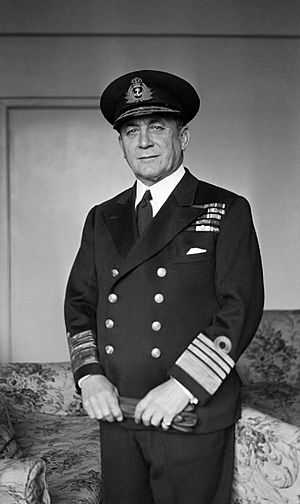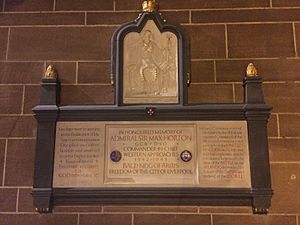Max Horton facts for kids
Quick facts for kids
Sir Max Kennedy Horton
|
|
|---|---|

Admiral Sir Max Horton, 1943
|
|
| Born | 29 November 1883 Rhosneigr, Anglesey |
| Died | 30 July 1951 (aged 67) London |
| Allegiance | United Kingdom |
| Service/ |
Royal Navy |
| Years of service | 1898–1945 |
| Rank | Admiral |
| Commands held | Western Approaches Command Flag Officer Submarines HMS E9 |
| Battles/wars | First World War
|
| Awards | Knight Grand Cross of the Order of the Bath Distinguished Service Order & Two Bars Sea Gallantry Medal Mentioned in dispatches Order of St. George (Russia) Order of St. Vladimir (Russia) Order of St. Anna (Russia) Order of St. Stanislaus (Russia) Legion of Honour (France) Croix de Guerre (France) Order of Orange-Nassau (Netherlands) Legion of Merit (United States) Order of St. Olaf (Norway) |
Sir Max Kennedy Horton (born November 29, 1883 – died July 30, 1951) was a brave British Admiral. He was a skilled submariner during the First World War. Later, in the Second World War, he led the Western Approaches Command, which was very important for the Battle of the Atlantic.
Contents
Max Horton was born in Anglesey, a place in Wales. His parents were Robert Joseph Angel Horton and Esther Maude Goldsmid.
He began his journey in the Royal Navy on September 15, 1898. He joined the officer training ship, HMS Britannia. While serving on HMS Duke of Edinburgh, he helped rescue people when a ship called SS Delhi got stuck. For his bravery, he received the Board of Trade Medal for Saving Life at Sea.
First World War Heroics
When the First World War began, Max Horton was a Lieutenant-Commander. He was in charge of HMS E9, one of Britain's first large submarines.
Sinking German Ships
On September 13, 1914, Horton made history. He used his submarine to torpedo the German ship SMS Hela. This happened near Heligoland. Hela was hit by two torpedoes and sank. Most of her crew were saved by other German ships.
Even though German forces chased E9 all day, Horton managed to get his submarine safely back to Harwich. When he arrived, he started a special tradition for British submariners. After a successful mission, they would fly a Jolly Roger flag.
Three weeks later, Horton sank another German ship, the destroyer S116. This happened near the river Ems. For sinking these two important ships, Horton was given the Distinguished Service Order (DSO).
Baltic Sea Missions
Horton and his submarine were then sent to the Baltic Sea. There, he sank many merchant ships. On July 2, 1915, he also damaged the German armored ship SMS Prinz Adalbert.
Horton was promoted to Commander on December 31, 1914. In 1917, he received a bar to his DSO. This was for his long and hard work leading submarines overseas. Three years later, as a captain, he earned a second bar to his DSO. This was for his great service leading the submarine group in the Baltic Sea.
Between the World Wars
In the 1920s, Horton commanded different ships. He was captain of HMS Conquest (1915) (HMS Conquest) and the large battleship HMS Resolution (09) (HMS Resolution).
He became a rear admiral in 1932. He then led the 2nd Battle Squadron and later the 1st Cruiser Squadron. In 1937, he was promoted to vice admiral. He was put in charge of the Reserve Fleet.
Second World War Leadership
When the Second World War started, Horton was given command of the Northern Patrol. This group helped block Germany's access to the sea. In 1940, he became Rear Admiral Submarines. Many people wanted Horton to lead the submarine forces because they knew he could make them stronger.
New Headquarters and Golf
Horton moved his main office to Northways in north London. He wanted more freedom to run his command. It is also said that Northways was close to some of his favorite golf courses. Horton loved golf and often played a round almost every day during the war.
Convoy Rescue Ships
Horton helped create convoy rescue ships. These ships traveled with convoys (groups of ships) to save sailors whose ships were sunk by enemy attacks. Rescue ships were like small cargo ships with extra space for people. They had special equipment to help rescue survivors from the water. They also had a small operating room and medical staff.
Leading the Battle of the Atlantic
On January 9, 1941, Horton became a full Admiral. On November 17, 1942, he was made Commander-in-Chief of the Western Approaches Command. This was a very important job.
He made smart changes to how escort ships protected convoys. Besides the usual escort groups, he created "support groups." These groups had more freedom to chase and destroy enemy submarines, even if it meant leaving the convoy for a while.
Horton's support groups were key in the spring of 1943. They fought hard against the German U-boats (submarines). Their strong attacks helped break the spirit of the U-boat crews. Many people believe Horton, along with Admiral Sir Percy Noble, was one of the most important people in the Allied victory in the Atlantic.
In August 1945, Max Horton retired from the Navy. He wanted younger officers to have a chance to be promoted. He received the Knight Grand Cross of the Order of the Bath in June 1945. He was also given the Freedom of the City of Liverpool.
Memorials and Legacy
There is a special memorial to Admiral Horton in Liverpool Cathedral.
In 2019, a statue of Horton was placed in Rhosneigr, where he was born. The community helped pay for it.
In 2021, a footstone was placed in his honor. It mentions his Jewish heritage and his important role in the Battle of the Atlantic.
A British anti-submarine ship, HMS Commander Horton, was named after him. Sadly, it was sunk in 1941.
Awards and Honors

- Knight Grand Cross of the Order of the Bath (1945)
- Distinguished Service Order and two bars (1914, 1917, 1920)
- Mention in Despatches (1940)
- The Board of Trade Medal for Saving Life at Sea in silver (1911)
- Order of St. George, 4th Class (Russia)
- Grand Officer of the Legion of Honour (France)
- Croix de Guerre with Palmes (France)
- Order of St. Vladimir 4th Class with swords (Russia)
- Order of St. Anna, 2nd Class with swords and diamonds (Russia)
- Order of St. Stanislaus 2nd Class (Russia)
- Grand Cross of the Order of Orange-Nassau (Netherlands, 1942)
- Chief Commander of Legion of Merit (USA, 1946)
- Grand Cross of the Order of St. Olaf (Norway, 1948)
Images for kids
| Military offices | ||
|---|---|---|
| Preceded by Sir Gerald Dickens |
Commander-in-Chief, Reserve Fleet 1937–1939 |
Succeeded by Post Disbanded |
| Preceded by Bertram Watson |
Rear-Admiral Submarines 1940–1942 |
Succeeded by Claud Barry |
| Heraldic offices | ||
| Preceded by Sir Walter Braithwaite |
King of Arms of the Order of the Bath 1946–1951 |
Succeeded by Sir James Robb |




